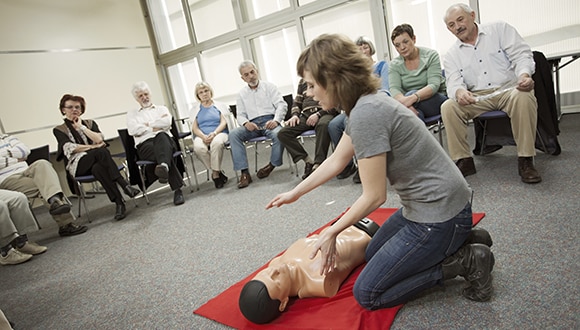Why you should learn CPR
In just 15 minutes you can learn skills that could save a life.
Health Agenda
April 2017
If someone standing next to you collapsed and had a cardiac arrest, what would you do? Every year around 30,000 Australians have a sudden cardiac arrest and only 10% of them survive.
Just 10%. But it doesn’t have to be this way. Seattle has seen survival rates hit 62% thanks to a program that provides CPR training to every emergency services worker and subsidised training for the public.
The program also subsidises defibrillators for businesses and community groups, so there are more of them around the city. When a cardiac arrest happens in Seattle, there’s a good chance someone nearby has the confidence and knowledge to act quickly – and every minute counts.

What is cardiac arrest?
In a cardiac arrest, your heart stops beating so blood isn’t pumped around the body and your brain is starved of oxygen. Heart attack is a common cause of cardiac arrest.
“As soon as your heart stops beating you have three to four minutes before you start to suffer brain damage due to lack of oxygen,” explains Professor Paul Middleton, Chair of Take Heart Australia, an organisation dedicated to increasing cardiac arrest survival rates. “Each minute your brain is starved of oxygen, your chance of survival decreases by 10%.”
Anyone who has a cardiac arrest can die within 10 minutes of their heart stopping. On average it takes 8 to 9 minutes for an ambulance to arrive. Performing CPR can be the difference between life and death.
“CPR substitutes for the heart pumping blood around the body – it’s not as good but it’s far better than nothing,” says Professor Middleton. “People may be afraid they’ll hurt someone or that they’ll get in to trouble but you can’t get in trouble for doing CPR, even if you do it badly.”
To see how easy it can be to save a life, watch this short video from St John New Zealand.
Key steps of CPR
First aid classes teach people to remember DRS-ABCD.
D – Danger
Check for danger before approaching the person (e.g. exposed needles or flammable liquids).
R – Response
Try to get a response by asking the person to say their name or squeeze your hand.
S – Send for help
Call 000 and send someone to find a defibrillator.
A – Airway
Check the airway is clear by gently rolling the person onto their back, tilting back their head and opening their mouth. If the airway is blocked, roll the person onto their side and clear it before continuing.
B – Breathing
Check if the person is breathing. If the person is breathing regularly, roll them onto their side, ensuring their head, neck and spine are aligned and continue to monitor them until help arrives.
C – Compressions
If the person isn't breathing, place the heel of one of your hands on the lower half of their breastbone, where the two halves of their ribcage meet in the centre of their chest. Place your other hand on top of your first hand and interlock your fingers.
Push down to a depth of one third of the victim’s chest and aim for about 120 compressions per minute, or two each second. Imagine ‘Stayin' Alive’ by the Bee Gees and do each compression to the beat of the music.
Just doing chest compressions will help, but if you can also do mouth-to-mouth, give two breaths for every 30 compressions. Open the person's airway by tilting back their head and lifting their chin. Close their nostrils with your finger and thumb, put your mouth over their mouth and blow. Give two full breaths. If their chest doesn’t rise and fall, just continue chest compressions until an ambulance or defibrillator arrives.
D – Defibrillator
If you have access to an automated external defibrillator (AED), apply the defibrillator pads as shown on the diagrams on the machine – pad-to-skin contact is important – and follow the voice prompts. Designed to be used by anyone, a defibrillator delivers an electric shock to ‘reboot’ the heart’s rhythm. An internal computer ensures it won’t deliver unnecessary shocks.
Where to find a defibrillator
• Hospital nursing stations
• Library and community centre foyers
• School offices or staff rooms
• Business centres
• Central areas of sports clubs and gyms
• Main areas of shopping centres (e.g. information desks)
Where to learn CPR
Find details of your nearest CPR course at:
• Australian Red Cross
• St John Ambulance Australia
• Surf Life Saving
“Basic CPR can be taught in 15 to 30 minutes,” says Professor Middleton. “People need to refresh their training every 12 months.”